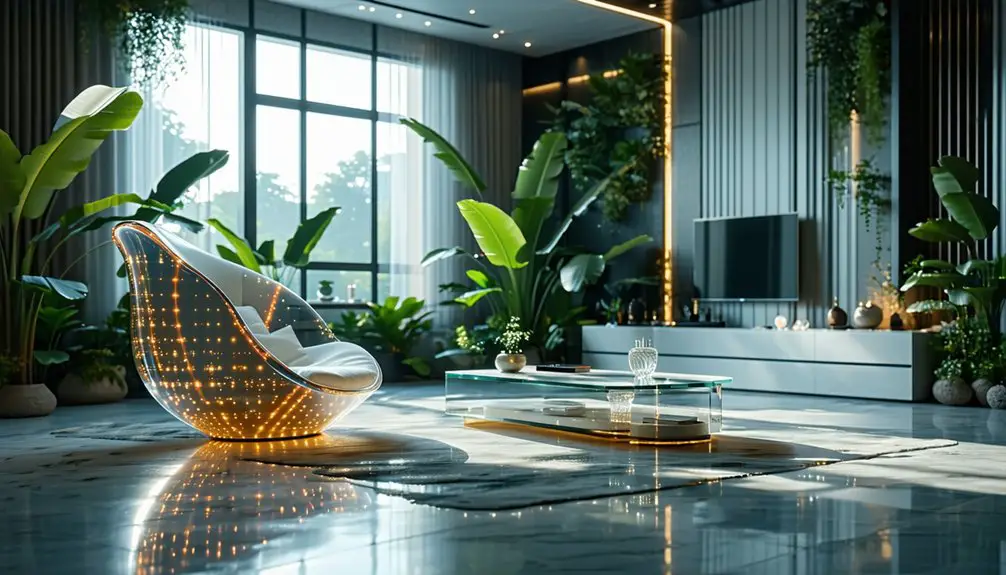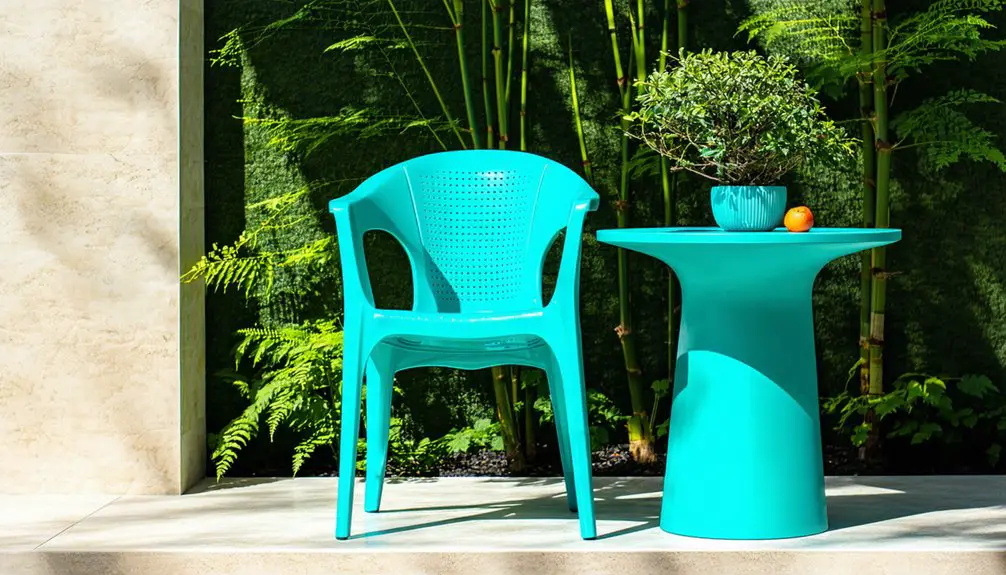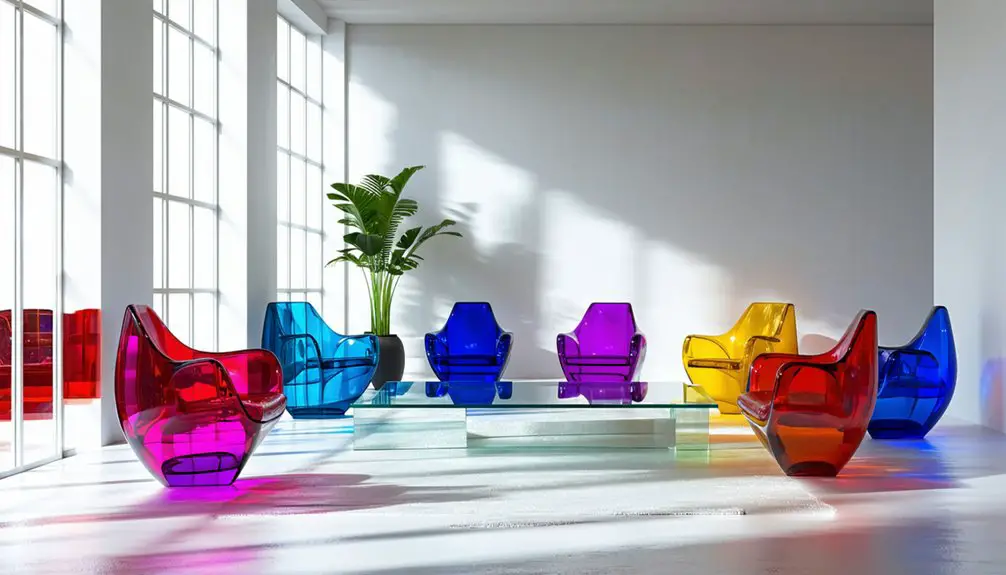The latest design trends in plastic furniture highlight sustainability and innovation. You'll find pieces made from recycled materials that support a circular economy. Modern manufacturing techniques, like 3D printing, allow for personalized designs and faster production. Smart furniture integrates IoT technology, offering features like posture monitoring and climate control. Aesthetics are sleek and contemporary, with customizable colors and ergonomics for comfort. Plus, durability is key, with high-grade plastics ensuring long-lasting performance. These trends reflect a growing demand for stylish yet eco-friendly choices in your living spaces. Discover how these elements are reshaping the furniture landscape.
Key Takeaways
- Modern plastic furniture emphasizes sleek, contemporary designs with clean lines, appealing to minimalist aesthetics.
- Customization options allow consumers to tailor colors and functionalities, enhancing personal style and usability.
- Sustainable materials, particularly recycled plastics, are increasingly prioritized to reduce environmental impact while maintaining design integrity.
- Innovative manufacturing techniques, like 3D printing, enable mass customization and rapid production, adapting to specific consumer needs.
- Ergonomic features are integrated into plastic furniture, promoting comfort and health through adjustable settings and lumbar support.
Sustainable Materials and Eco-Friendly Designs
As you explore the world of plastic furniture, you'll quickly notice a significant shift towards sustainable materials and eco-friendly designs. Recycled HDPE, made from post-consumer waste like plastic bottles, plays a key role in this trend. By transforming everyday items, such as milk jugs, into durable poly lumber, manufacturers reduce landfill waste and lessen the demand for virgin resources.
The durability of recycled HDPE furniture is impressive; it stands up to weather damage, moisture, and pests without splintering or rotting. This means you can enjoy outdoor seating without worrying about wear and tear. Additionally, HDPE furniture resists wear and tear compared to wood or metal, making it a lasting choice for outdoor spaces. Furthermore, polypropylene is also a suitable choice for indoor and outdoor use due to its heat resistant properties.
Low maintenance is another perk—you only need soap and water to keep it clean. Using sustainable materials also brings environmental benefits. It cuts down on landfill waste and lowers the carbon footprint by requiring less energy than producing new plastics, which greatly contributes to Circular Economy initiatives. Plus, these materials can be recycled at the end of their life cycle, supporting a circular economy. When you choose furniture that emphasizes ethical sourcing and resource conservation, you're not just selecting stylish pieces; you're making a conscious choice for the planet.
Make your space eco-friendly with sustainable designs that combine style and responsibility.
Innovative Manufacturing Techniques
In today's furniture design landscape, you're seeing remarkable advancements in 3D printing that allow for on-demand production tailored to your specific needs. These innovative techniques not only enhance design flexibility but also meet high purity standards, ensuring durable and reliable products. Additionally, the use of advanced technologies in custom plastic furniture manufacturing further contributes to exceptional accuracy and durability in the final products. Let's explore how these manufacturing methods are reshaping the way plastic furniture is made.
3D Printing Advancements
While exploring innovative manufacturing techniques, it's clear that advancements in 3D printing are revolutionizing the plastic furniture industry. With the introduction of biocompatible polymers and sustainable materials, the focus is shifting towards creating eco-friendly and durable pieces. Large-scale 3D printing capabilities, like pellet extrusion, dramatically reduce material costs and allow for intricate designs that traditional methods can't match. Additionally, large-scale 3D printing enables the creation of functional and stylish furniture, including items like chairs and tables.
Here's a quick look at the different aspects of 3D printing advancements:
| Advancements | Benefits |
|---|---|
| Biocompatible Polymers | Safe for medical and pharmaceutical use |
| Large-Scale Printing | Reduces costs and increases efficiency |
| Composite Materials | Enhanced strength and durability |
| Customized Designs | Personalization for unique furniture |
| Sustainable Materials | Lower environmental impact |
These innovations enable manufacturers to create lightweight yet strong furniture, optimizing material use and minimizing waste. Additionally, the integration of AI enhances design capabilities, allowing for faster blueprinting and production. As these technologies continue to evolve, you can expect to see even more creative and functional designs in the realm of plastic furniture.
On-Demand Production Benefits
On-demand production is transforming the plastic furniture industry by offering significant benefits that cater to today's market demands. This innovative approach allows you to produce furniture in the exact quantities and specifications you need, minimizing waste and optimizing resources.
With low-volume manufacturing, you can create prototypes or small batches without incurring hefty costs for hardware changes.
Here are some key advantages of on-demand production:
- Cost efficiency: Reduces warehousing and logistics costs by minimizing inventory.
- Customization: Supports mass customization through digital technologies, enabling unique designs tailored to customer preferences.
- Faster turnaround: Achieves quicker delivery times, often within days, thanks to streamlined production processes.
- Reduced waste: Minimizes excess inventory, helping you avoid disposal costs and environmental impact.
- Agility: Adapts swiftly to changing market demands and customer requests, allowing for rapid adjustments in production. Additionally, on-demand manufacturing minimizes waste, ensuring that only necessary quantities are produced, which further enhances sustainability in the industry.
High Purity Standards
The shift towards on-demand production naturally leads to a focus on high purity standards in manufacturing plastic furniture. You'll find that manufacturers are selecting high-grade plastics like polypropylene, polyethylene, and polycarbonate for their durability, flexibility, and eco-friendliness.
Each production batch undergoes stringent quality control measures, ensuring consistency and reliability. They test samples for strength, durability, and dimensional accuracy, swiftly addressing any defects. Collaborative Robots in Furniture Production are increasingly being integrated into these processes to further enhance efficiency.
Advanced manufacturing techniques play a crucial role here. Injection molding, where plastic pellets are melted and injected into molds under high pressure, ensures precision and durability.
Automated systems and robotics streamline the process, enhancing both consistency and efficiency. Techniques like 1K injection molding and overmolding with metal and glass inputs elevate product quality.
Moreover, sustainability is a priority. More than 50% of products are crafted from recycled plastics, and advancements have led to the use of biodegradable materials.
Each product also undergoes rigorous safety and chemical testing, ensuring they meet stringent standards. Certifications like the EN581 test guarantee safety, stability, and the absence of harmful toxins.
Smart and Connected Furniture

Embracing the future of home and office spaces, smart and connected furniture is revolutionizing how we interact with our environments. With the integration of IoT technology, these innovative pieces not only enhance comfort but also improve functionality.
Imagine a smart chair that adjusts to your posture or connects seamlessly with your other smart devices.
Here are some key features of smart and connected furniture:
- Real-time posture monitoring: Get immediate feedback to maintain proper posture and comfort.
- Seamless integration: Control lighting, temperature, and entertainment systems directly from your chair.
- Automatic adjustments: Chairs adapt to your body metrics, ensuring optimal comfort at all times.
- Data-driven insights: Analyze your habits to enhance productivity and well-being.
- Enhanced quality control: IoT sensors ensure high standards during production, leading to better products.
The focus on ergonomic and health-oriented features makes smart furniture a game-changer, especially in office settings.
As sustainability becomes more critical, these designs are also leaning towards eco-friendly materials, ensuring you can enjoy modern convenience without compromising the planet.
With smart and connected furniture, you're not just investing in style—you're embracing a healthier, more efficient lifestyle.
Design Aesthetics and Customization
Shaping your space with modern design aesthetics and customization options in plastic furniture can transform the look and feel of any environment.
Today's designs have moved away from bulky styles to embrace sleek, contemporary appearances that emphasize clean lines and simplicity. Minimalist chairs and stylish dining sets not only enhance your decor but also offer functional elements that cater to your needs.
Customization is a game-changer. You can tailor the layout, shade, and capabilities of your furniture to fit your specific preferences. Whether you're looking for a particular color palette or need event-specific designs that harmonize with your gathering's theme, the possibilities are endless.
This flexibility ensures that your furniture not only meets your functional desires but also reflects your unique style.
Boundary-pushing manufacturers are continuously innovating, integrating eco-friendly materials into their designs while maintaining aesthetic standards. From recycled plastic options to advanced manufacturing techniques, you can enjoy furniture that isn't only visually appealing but also sustainable.
With these modern trends, you can effortlessly create a space that's both stylish and tailored to your lifestyle.
Durability and Enhanced Performance

Modern design aesthetics and customization in plastic furniture not only enhance your space but also set the stage for durability and performance.
You'll find that today's plastic furniture is engineered to withstand the rigors of daily use and the unpredictability of the elements. Materials like high-density polyethylene (HDPE) and polypropylene are chosen for their exceptional strength and weather-resistant qualities, ensuring your furniture lasts longer.
Here are some key features to consider:
- Robust Manufacturing: Injection and rotational molding processes strengthen each piece from the start.
- UV Protection: Additives like UV stabilizers help prevent fading and degradation from sunlight exposure.
- Weather Resistance: Designed to endure moisture and extreme temperatures, ensuring outdoor furniture remains vibrant.
- Low Maintenance: Routine cleaning keeps furniture looking fresh, and protective sprays further extend its life.
- Cost-Effective: Durable materials reduce the need for replacements, making it a smart investment.
Ergonomic and Health-Focused Designs
In today's fast-paced world, ergonomic and health-focused designs in plastic furniture are more crucial than ever. You'll find that modern chairs now incorporate better lumbar support, significantly reducing the risk of musculoskeletal issues.
Adjustable features, such as height and tilt settings, promote good posture, helping you feel comfortable during long hours of work or leisure.
Moreover, many designs cater specifically to health needs, especially in work-from-home and office settings. You can enjoy materials that enhance comfort while reducing strain on your back and legs.
These health-focused features not only improve overall well-being but also tackle the risks associated with poor posture and prolonged sitting.
Customization is key, too. You can choose colors, shapes, and finishes that match your personal style while enjoying lightweight, stackable designs that adapt to various activities.
Innovative materials like biodegradable plastics also support sustainability without sacrificing comfort.
Frequently Asked Questions
What Are the Environmental Benefits of Using Recycled Plastic Furniture?
Using recycled plastic furniture helps reduce landfill waste, conserves energy, and minimizes greenhouse gas emissions. You're supporting a circular economy while enjoying durable, low-maintenance products that save you money in the long run.
How Long Does Recycled Plastic Furniture Typically Last?
Recycled plastic furniture typically lasts over 50 years with proper care. You'll find it outlasts traditional materials, requiring minimal maintenance while resisting environmental factors like rot, rust, and UV damage, ensuring long-term use.
Can Plastic Furniture Be Recycled Again After Use?
Yes, plastic furniture can be recycled again after use. Once collected, it goes through sorting, cleaning, and shredding processes, allowing it to be transformed into new products, promoting sustainability and minimizing landfill waste.
Is Plastic Furniture Safe for Outdoor Use?
Yes, plastic furniture is safe for outdoor use. It's durable, UV-resistant, and moisture-resistant, ensuring it withstands harsh weather conditions. Just keep it clean and protected to maintain its longevity and aesthetic appeal.
What Maintenance Is Required for Plastic Furniture?
To maintain plastic furniture, clean it regularly with mild soap and water, inspect for damage, and store it indoors when not in use. Protect it from extreme weather and avoid harsh chemicals to prolong its life.

